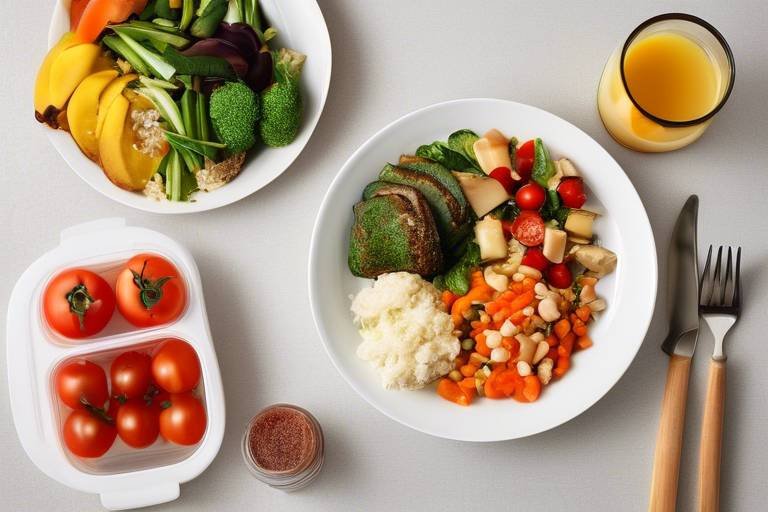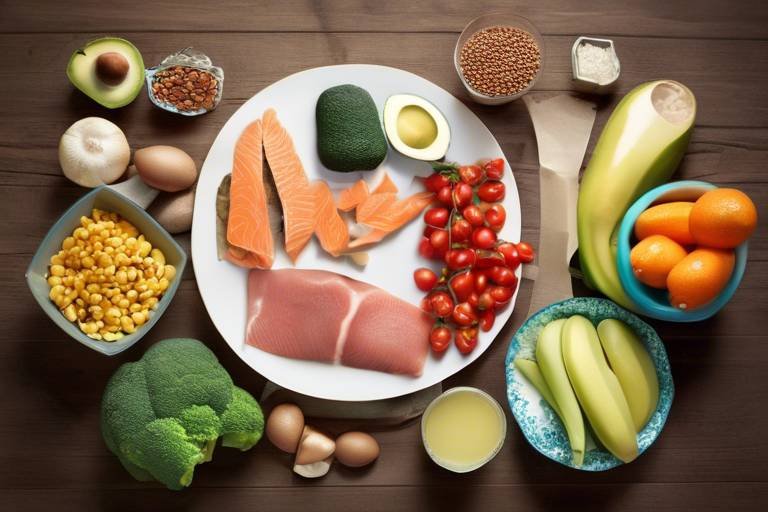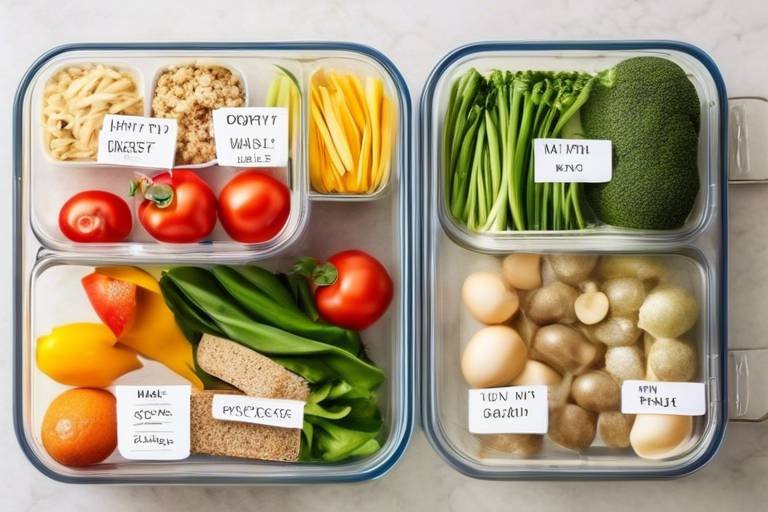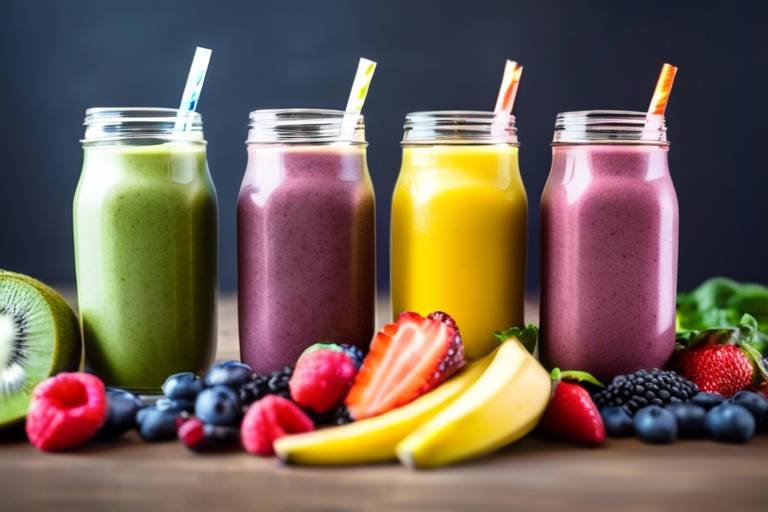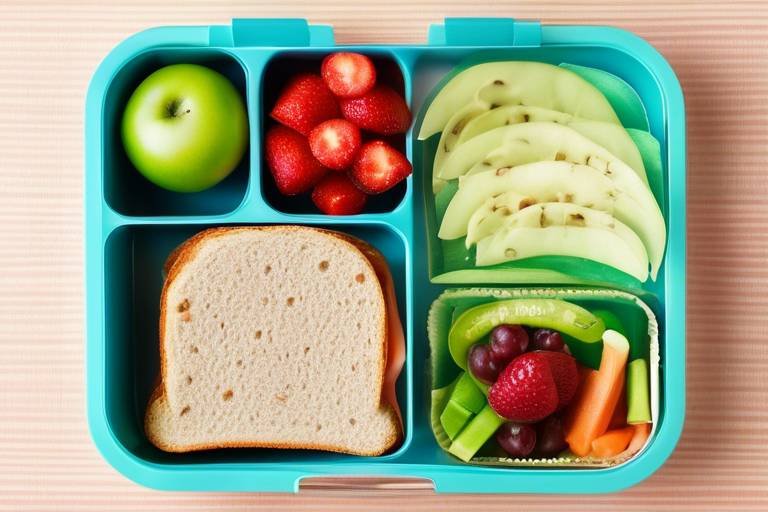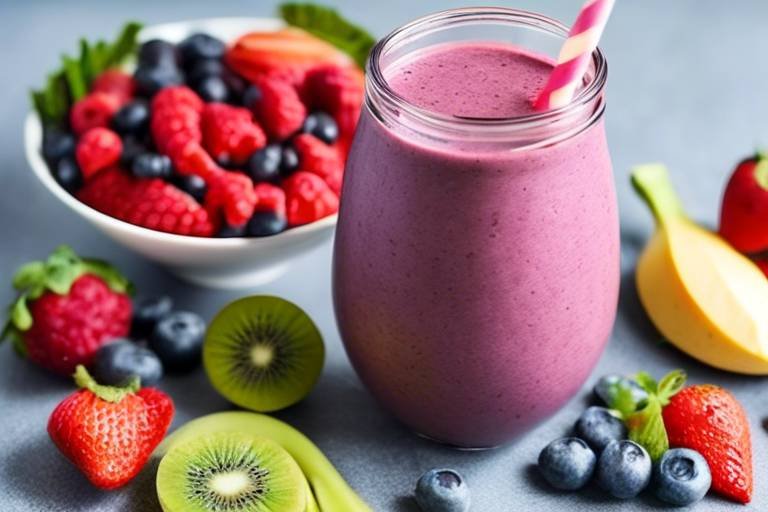A Guide to Healthier Holiday Eating for the Whole Family
The holiday season is a time filled with joy, laughter, and, of course, an abundance of food. However, it can also be a period where our healthy eating habits take a backseat to festive indulgences. But fear not! This guide is here to help you navigate the holiday feasts without compromising your health or well-being. Imagine a holiday dinner where everyone leaves the table feeling satisfied yet energized, rather than sluggish and overly stuffed. Sounds incredible, right? With a little planning and creativity, you can achieve just that!
In this article, we will explore practical tips and strategies for maintaining healthy eating habits during the holiday season. We’ll delve into understanding the nutritional challenges that arise during this time, smart meal planning techniques, and how to engage the whole family in the process. After all, the holidays are not just about food; they are about family, connection, and creating lasting memories together. So, let’s dive in and discover how to make this holiday season both festive and nutritious!
During the holiday season, our plates often overflow with rich, calorie-laden dishes that can derail even the most dedicated health enthusiasts. Understanding the nutritional challenges that come with traditional holiday meals is the first step toward making informed choices. From creamy casseroles to sugary desserts, it’s easy to see how one could easily overindulge. But what if we could balance indulgence with health? By being mindful of our food choices and focusing on nutrition, we can enjoy the festive flavors while still feeling good about what we eat.
Think of nutrition as a balancing act. You can have your favorite holiday dishes while incorporating healthier options. This might mean swapping out heavy cream for Greek yogurt in your mashed potatoes or using whole grains instead of refined ones in your stuffing. By making small adjustments, you can create meals that are both delicious and nutritious. Remember, it’s not about deprivation; it’s about making smarter choices that support your health goals!
Effective meal planning is your best ally during the holiday season. It can prevent those last-minute unhealthy food choices that often arise when we’re caught off guard. To keep your family satisfied while also being mindful of nutrition, consider creating a balanced menu that caters to everyone's cravings. Think of it as crafting a symphony of flavors where each dish plays its part harmoniously.
A well-thought-out menu can include a variety of dishes, ensuring that there’s something for everyone. Here’s a simple example of how you can structure your holiday meal:
| Course | Dishes |
|---|---|
| Appetizers | Veggie platter with hummus, whole-grain crackers, and cheese |
| Main Course | Roasted turkey, quinoa stuffing, and a variety of seasonal veggies |
| Dessert | Fruit salad, dark chocolate dipped strawberries |
By planning ahead, you can create a menu that satisfies both taste buds and nutritional needs. And don’t forget to involve the family in the planning process! This not only makes it more fun but also encourages everyone to be mindful of what they’re eating.
One of the best ways to enhance both the flavor and nutrition of your holiday meals is by incorporating seasonal ingredients. Not only do they taste better, but they are also packed with nutrients that can boost your health. During the holiday season, look for ingredients like:
- Brussels sprouts
- Squash
- Sweet potatoes
- Pears
- Apples
These ingredients can be easily transformed into mouthwatering dishes that everyone will love. For example, roasted Brussels sprouts drizzled with balsamic glaze can be a show-stopper on your holiday table. Or how about a sweet potato casserole topped with a crunchy pecan crust? The possibilities are endless!
Let’s face it: vegetables often get a bad rap during the holidays. But with a little creativity, you can make them the star of the show! Think of innovative ways to prepare vegetables that appeal to both kids and adults. Try spiralizing zucchini into noodles or making cauliflower mash as a healthier alternative to mashed potatoes. You might be surprised at how quickly everyone gobbles them up!
We all love desserts during the holidays, but that doesn’t mean they have to be loaded with sugar and unhealthy fats. Explore healthier alternatives that satisfy your sweet tooth without the guilt. For instance, consider using ripe bananas or applesauce as natural sweeteners in your baked goods. You can also substitute traditional flour with almond or coconut flour for a healthier twist.
By getting creative with your desserts, you can enjoy sweet treats that are both delicious and nutritious. Imagine indulging in a rich chocolate avocado mousse or a pumpkin pie made with a nut-based crust. Your guests will be raving about these healthier options long after the holiday season is over!
Understanding portion sizes is crucial for healthier eating during the holidays. It’s easy to pile on the food when everything looks so delicious, but practicing portion control allows for enjoyment without overindulgence. Consider using smaller plates to help manage serving sizes, and encourage everyone to take a moment to savor their food rather than rushing through the meal.
It’s all about balance. Enjoy a little bit of everything, but be mindful of how much you’re putting on your plate. Remember, it’s perfectly fine to go back for seconds if you’re still hungry, but try to wait a few minutes after your first serving to see if you really need more. This simple strategy can help you avoid that uncomfortable, overly stuffed feeling!
Getting the whole family involved in meal preparation can promote healthier eating habits and create a sense of togetherness. Cooking can be a fun and educational experience, especially for kids. Involve them in the kitchen by assigning age-appropriate tasks, whether it’s washing vegetables, stirring sauces, or decorating cookies. This not only teaches them valuable cooking skills but also fosters a love for healthy foods.
Engaging children in the kitchen can transform meal prep into a fun bonding activity. Try hosting a “family cooking night” where everyone contributes to the meal. You might even create a friendly competition by dividing into teams to see who can come up with the most creative dish using a set list of ingredients. Not only does this encourage teamwork, but it also gets everyone excited about trying new foods.
Creating new healthy traditions can enhance family bonding during the holiday season. Think about ways to incorporate healthier meals into your holiday rituals. Perhaps you can start a tradition of making a healthy breakfast together on Christmas morning, or you could host a potluck where everyone brings a nutritious dish to share. These traditions can become cherished memories while also promoting healthier eating habits.
Q: How can I make my holiday meals healthier without sacrificing flavor?
A: Focus on incorporating seasonal ingredients, using healthier cooking methods like roasting or steaming, and experimenting with spices and herbs to enhance flavor without added calories.
Q: What are some good alternatives for traditional holiday desserts?
A: Consider using natural sweeteners, whole grains, and healthier fats. Desserts like fruit salads, dark chocolate treats, or baked goods made with almond flour can be delicious and nutritious options.
Q: How can I encourage my kids to eat healthier during the holidays?
A: Involve them in meal prep, offer a variety of colorful fruits and vegetables, and make healthy eating fun by creating a cooking activity or a family challenge.

Understanding Holiday Nutrition
When the holiday season rolls around, it's like stepping into a wonderland of flavors and aromas. However, amidst the festivities, it's easy to lose sight of our nutritional goals. The challenge is to enjoy the delicious foods that come with the season without compromising our health. So, what exactly are the nutritional challenges we face during this time? Well, let’s dive into it!
First off, many holiday meals are laden with calories, sugar, and unhealthy fats, often leading to overindulgence. Think about it—those rich gravies, creamy mashed potatoes, and decadent desserts can easily add up. Moreover, the absence of nutritious options can make it hard to balance your plate. It’s a classic case of “out of sight, out of mind.” To combat this, families should aim to incorporate a variety of food groups, ensuring that meals are not only festive but also nutrient-rich.
One of the biggest culprits during the holiday season is the infamous buffet-style dining. It’s a free-for-all that tempts you to pile your plate high. But here’s a thought: why not make a conscious effort to fill half your plate with vegetables? This simple act can significantly increase your fiber intake and help you feel fuller, reducing the temptation to overindulge in the more decadent items. Remember, it’s all about balance!
Additionally, let’s not forget about the drinks. Holiday beverages can be just as calorie-dense as the food. Eggnog, sugary cocktails, and even festive coffees can pack a serious punch. To keep things in check, consider opting for healthier alternatives like sparkling water with fresh fruit or herbal teas. These options can be refreshing and festive without the extra calories.
To further illustrate the nutritional landscape during the holidays, here’s a quick comparison of typical holiday foods versus healthier alternatives:
| Traditional Holiday Food | Healthier Alternative |
|---|---|
| Stuffing with butter | Whole grain stuffing with vegetable broth |
| Creamy mashed potatoes | Mashed cauliflower or sweet potatoes |
| Pumpkin pie with whipped cream | Plain pumpkin puree with a sprinkle of cinnamon |
| Rich chocolate cake | Dark chocolate with nuts or fruit |
By making informed choices and understanding the nutritional value of the foods we consume, families can enjoy the holiday season without the guilt. So, as you plan your festive meals, remember that it’s possible to indulge while still keeping your health in check. Why not make this holiday season not just about celebration, but also about wellness?

Smart Meal Planning
When the holiday season rolls around, it can feel like a culinary rollercoaster. With all the festive gatherings, delicious treats, and the temptation to indulge, how can we keep our meals both tasty and healthy? The answer lies in . This approach not only helps you avoid those last-minute unhealthy food choices but also ensures that your family enjoys a balanced menu that satisfies everyone's cravings. Imagine walking into a holiday gathering where the food is both delightful and nutritious—sounds like a dream, right?
To kick off your smart meal planning, start by making a list of the meals you'll be serving throughout the holiday season. Consider including a variety of dishes that cater to different tastes and dietary needs. For instance, you might want to incorporate traditional favorites alongside healthier options. This way, everyone feels included, and you also introduce a bit of excitement into your holiday spread.
One effective strategy is to create a balanced menu. Think of it like composing a symphony: you need a mix of flavors, textures, and colors to create a harmonious dining experience. For example, you could pair a rich, savory main dish with lighter sides like roasted vegetables or a fresh salad. This not only enhances the meal but also keeps the nutritional value at the forefront. Here’s a quick table to illustrate how you might balance your holiday menu:
| Main Dish | Side Dish | Dessert |
|---|---|---|
| Herb-Roasted Turkey | Quinoa Salad with Seasonal Veggies | Dark Chocolate Avocado Mousse |
| Honey Glazed Ham | Garlic Mashed Cauliflower | Fruit Salad with Honey-Lime Dressing |
Now, let’s talk about portion control. It’s easy to get carried away during the holidays, but being mindful of serving sizes can help you enjoy your favorite foods without overindulging. A good rule of thumb is to fill half your plate with vegetables, a quarter with protein, and the remaining quarter with carbohydrates. This not only keeps your meals balanced but also helps you feel satisfied without the dreaded post-feast slump.
Another tip is to prepare some meals in advance. This way, you can avoid the last-minute rush and the temptation to grab unhealthy snacks. Consider batch-cooking healthy options that you can freeze and reheat later. This not only saves time but also ensures that you have nutritious meals ready to go, even on the busiest days. Plus, it can be a fun family activity to get everyone involved in the cooking process!
Finally, don’t forget to incorporate seasonal ingredients into your holiday meals. Not only do they taste better, but they also provide a nutritional boost. Think about using winter favorites like Brussels sprouts, sweet potatoes, and cranberries. These ingredients can elevate your dishes and make them festive, while also providing essential vitamins and minerals that are vital during the colder months.
In conclusion, smart meal planning during the holiday season is all about balance, creativity, and involvement. By being intentional about what you serve and how you prepare it, you can create a holiday experience that is both enjoyable and healthy for the whole family. So roll up your sleeves, gather your loved ones, and start planning those delicious holiday meals!
- How can I make sure my holiday meals are healthy? Focus on using fresh, seasonal ingredients, control portion sizes, and include a variety of dishes that cater to different dietary needs.
- What are some easy healthy dessert options? Consider desserts made with whole ingredients, like fruit salads, yogurt parfaits, or dark chocolate treats that use healthier fats.
- Can I involve my kids in meal planning? Absolutely! Involving children in meal preparation can teach them about nutrition and make them more excited about healthy eating.

Incorporating Seasonal Ingredients
When it comes to holiday meals, one of the best ways to enhance flavor while boosting nutrition is by incorporating seasonal ingredients. Not only do these ingredients taste better, but they are also fresher and more nutrient-dense, making them a fantastic choice for your festive dishes. Think about it: when you eat foods that are in season, you’re not just supporting your health, but you’re also supporting local farmers and reducing your carbon footprint. It’s a win-win!
So, what exactly is in season during the holiday months? Depending on your location, you can find a variety of fruits and vegetables that can elevate your holiday meals. For instance, root vegetables like carrots, sweet potatoes, and beets are not only hearty but also packed with vitamins and minerals. These can be roasted, mashed, or even turned into a vibrant salad. Additionally, winter greens such as kale and spinach are perfect for adding a nutritious crunch to your meals.
Fruits like citrus are also in season, bringing a zesty brightness to your holiday table. Oranges, grapefruits, and lemons can be used in salads, desserts, or as garnishes to lift the flavors of your dishes. Imagine a refreshing winter salad topped with segmented oranges and a light vinaigrette—delicious and nutritious!
Let’s not forget about herbs! Fresh herbs like rosemary, thyme, and sage can transform a simple dish into something extraordinary. They add depth and aroma, making your meals feel festive without extra calories. Consider using these herbs in your stuffing, roasted meats, or even sprinkled over vegetables for that extra touch of flavor.
To help you visualize the seasonal ingredients, here’s a quick table summarizing some popular choices:
| Type | Seasonal Ingredients | Suggested Uses |
|---|---|---|
| Fruits | Citrus (Oranges, Grapefruits) | Salads, Desserts, Garnishes |
| Vegetables | Root Vegetables (Carrots, Sweet Potatoes) | Roasting, Mashing, Salads |
| Greens | Winter Greens (Kale, Spinach) | Salads, Sautéing, Smoothies |
| Herbs | Rosemary, Thyme, Sage | Stuffing, Roasted Dishes, Seasoning |
Incorporating these seasonal ingredients into your holiday meals doesn’t have to be a chore. In fact, it can be a fun adventure for the whole family! Get everyone involved in shopping for these fresh ingredients at your local farmer's market or grocery store. You can turn it into a mini scavenger hunt, where each family member finds a specific ingredient to contribute to the meal. This not only makes meal prep more enjoyable but also teaches everyone about the importance of eating seasonal and local foods.
By making a conscious effort to include seasonal ingredients in your holiday cooking, you not only enhance the flavors of your meals but also take a step towards healthier eating. So, why not give it a try? Your taste buds—and your body—will thank you!

Creative Vegetable Dishes
When it comes to holiday meals, vegetables often take a backseat to more indulgent dishes, but they can be the star of the show with a little creativity! Imagine your family gathering around a table adorned with vibrant, colorful vegetable dishes that not only look appealing but also taste amazing. The key is to transform these often-overlooked ingredients into delightful creations that everyone will love. After all, who said veggies can't be fun?
One fantastic way to make vegetables more exciting is by experimenting with different cooking methods. Instead of the usual steamed broccoli, why not try roasting a medley of seasonal vegetables? Roasting caramelizes their natural sugars, resulting in a sweet, savory flavor that even the pickiest eaters will enjoy. Think about tossing together carrots, Brussels sprouts, and sweet potatoes, drizzled with olive oil and sprinkled with herbs. The aroma alone will have your family eagerly anticipating dinner!
Another creative approach is to incorporate vegetables into dishes that are typically not vegetable-centric. For instance, you can sneak in finely chopped spinach or zucchini into your holiday meatballs or even mix some shredded carrots into mashed potatoes. This not only boosts the nutritional value but also adds a subtle flavor that might just surprise everyone at the table.
But let’s not stop there! Why not get a little adventurous with your presentation? Serving vegetables in fun shapes or colors can make them more appealing to kids. You could use a spiralizer to create zoodles (zucchini noodles) or a mandoline to make colorful vegetable ribbons. Pair these with a tasty homemade pesto or a light marinara sauce, and you have a dish that’s not only healthy but also visually stunning!
Here’s a quick idea to get you started: try making a vegetable platter that doubles as an art piece. Arrange an array of colorful veggies like bell peppers, cherry tomatoes, and radishes in a way that resembles a festive holiday wreath. Serve it with a delicious dip made from Greek yogurt and herbs. This not only encourages everyone to munch on their veggies but also adds a creative flair to your holiday spread.
As the holiday season approaches, remember that the goal is to make vegetables exciting and enjoyable for everyone. With a little imagination and some innovative cooking techniques, you can create dishes that will have your family asking for seconds—without any guilt attached. So, roll up your sleeves, grab those veggies, and let your culinary creativity shine!
Q: How can I encourage my kids to eat more vegetables during the holidays?
A: Involve them in the cooking process! Let them help with washing, peeling, and even choosing the vegetables. Making it a fun activity can spark their interest in trying new things.
Q: What are some easy vegetable dishes I can prepare for holiday gatherings?
A: Consider roasted vegetable medleys, stuffed bell peppers, or a colorful vegetable platter with dips. These are not only easy to prepare but also visually appealing!
Q: How can I make vegetables more appealing to picky eaters?
A: Try different cooking methods like roasting, grilling, or even sautéing with flavorful spices and herbs. Presentation is key, so make the dish colorful and fun!

Healthier Dessert Options
When it comes to holiday feasting, desserts often steal the show, but they can also be a major source of sugar and empty calories. The good news is that you can still indulge your sweet tooth without sacrificing your health. By making a few simple swaps and utilizing wholesome ingredients, you can create delicious desserts that everyone will love. Imagine biting into a slice of rich, chocolate cake made with whole wheat flour and sweetened with ripe bananas instead of refined sugar. Sounds tempting, right?
One way to make your desserts healthier is by incorporating natural sweeteners. Instead of using granulated sugar, try using honey, maple syrup, or even dates. These alternatives not only add sweetness but also come packed with nutrients. For instance, dates are rich in fiber and can help with digestion, making them a great addition to your holiday treats. You can blend them into a paste and use it as a sweetener in various recipes.
Another key strategy is to focus on adding fruits to your desserts. Fruits can provide a burst of flavor and natural sweetness, plus they bring essential vitamins and minerals to the table. Consider making a fruit salad with seasonal fruits like pomegranates, oranges, and apples. Toss them with a bit of yogurt and a sprinkle of cinnamon for a refreshing and healthy dessert option that will leave your guests feeling satisfied without the sugar crash.
For those who love baked goods, consider making healthier versions of classic recipes. For example, you can create oatmeal cookies using rolled oats, mashed bananas, and a handful of dark chocolate chips. These cookies are not only easy to make but also provide a good source of fiber and antioxidants. If you want to take it a step further, try adding nuts or seeds for an extra crunch and nutritional boost.
Let’s not forget about the power of substitutions in your favorite dessert recipes. Instead of using heavy cream for frosting, why not try a whipped coconut cream? It’s light, fluffy, and adds a tropical twist to your cakes and pies. You can also use Greek yogurt as a base for cheesecakes, which will give you that creamy texture while cutting down on calories and fat.
Lastly, remember that portion control is key, even with healthier desserts. Instead of serving large slices of cake, cut them into smaller pieces, allowing everyone to enjoy a taste without overindulging. You can even create a dessert bar where guests can choose smaller portions of various treats, making for a fun and interactive way to enjoy sweets while keeping health in mind.
In summary, healthier dessert options don’t have to be boring or bland. With a bit of creativity and a focus on wholesome ingredients, you can whip up festive treats that satisfy your cravings and keep your family's health in check. So this holiday season, let your desserts shine with nutritional value and flavor, proving that you can indeed have your cake and eat it too!

Portion Control Strategies
When it comes to enjoying holiday meals without the guilt, portion control is a game changer. It’s all about finding that sweet spot where you can indulge in your favorite festive dishes while also keeping your health in check. Think of your plate as a canvas; you want to create a beautiful masterpiece that’s not only visually appealing but also balanced and nutritious. So, how do you achieve this balance? Let’s dive in!
First off, understanding what a healthy portion looks like is crucial. Many of us tend to underestimate how much we actually need. A great way to visualize this is by using the plate method. Imagine dividing your plate into sections: half of it should be filled with colorful vegetables, one-quarter with lean protein, and the remaining quarter with whole grains. This simple strategy not only helps in maintaining a balanced diet but also makes your meal visually appealing.
Another effective strategy is to use smaller plates and bowls. It’s a psychological trick that can make a big difference in how much food you consume. When you serve your meal on a smaller plate, it tricks your brain into thinking you’re eating more than you actually are. Plus, it encourages you to savor each bite, allowing your body to recognize when it’s full.
Let’s not forget about the importance of mindful eating. During the holidays, it’s easy to get caught up in the festivities and munch mindlessly. Try to slow down and really enjoy your food. Engage your senses: notice the flavors, textures, and aromas. This practice not only enhances your dining experience but also helps your body signal when it’s had enough.
For those who love to host, consider serving food in individual portions. This not only adds a touch of elegance to your table but also makes it easier for guests to manage their servings. Think mini quiches, small bowls of salad, or even dessert shots. It’s a fun way to encourage moderation without sacrificing flavor!
Finally, don’t forget to listen to your body. Everyone’s hunger cues are different, and it’s important to respect them. If you’re still hungry after your first plate, wait a few minutes before going back for seconds. Often, you’ll find that your body has had enough time to register fullness.
In summary, mastering portion control during the holiday season doesn’t have to be a chore. By using visual aids, practicing mindful eating, and serving food in smaller portions, you can enjoy festive meals without overindulging. After all, the holidays are about celebrating with loved ones, and maintaining a healthy balance can make those celebrations even more enjoyable!

Engaging the Whole Family
When it comes to holiday meals, getting the whole family involved can transform the experience from just another meal into a fun-filled bonding activity. Imagine the laughter echoing in the kitchen as everyone pitches in, from the youngest to the oldest. Engaging every family member not only fosters a sense of teamwork but also instills healthy eating habits that can last a lifetime. So, how do we make cooking a delightful experience for everyone? Let's dive into some exciting ways to get everyone on board!
First off, why not turn cooking into a family adventure? Set a theme for your holiday meal and let each family member contribute their ideas. For example, if you’re planning a traditional feast, each person can take charge of a different dish. This not only makes the process collaborative but also allows everyone to showcase their culinary skills (or learn some new ones!). Plus, it’s a fantastic way to introduce children to the importance of nutrition and healthy ingredients.
Another great way to engage the family is through fun cooking activities. Consider organizing a “chopped” style competition where family members can create dishes using a set list of healthy ingredients. This not only makes cooking exciting but also encourages creativity in the kitchen. You could even have a taste test at the end to see which dish is the favorite! This approach not only teaches kids about healthy choices but also allows them to express their creativity.
Creating family meal traditions is another wonderful way to engage everyone. Think about incorporating a healthy twist to your holiday rituals. For instance, if your family traditionally enjoys a certain dish, why not try a healthier version? This could be a whole grain stuffing instead of the usual white bread or roasted vegetables instead of creamy casseroles. By making small changes, you can create a new tradition that everyone looks forward to while still keeping health in mind.
Don't forget about the power of storytelling during meal prep! As you chop vegetables or stir sauces, share stories from past holidays. What did Grandma make? What funny mishaps happened in the kitchen? These stories create a rich tapestry of family history, making the meal more meaningful. Plus, it’s a great way to teach kids about their heritage and the importance of family bonding over meals.
Lastly, remember that the goal is to make cooking a joyful experience rather than a chore. Play some festive music, dance a little, and enjoy the process. When the kitchen is filled with laughter and love, the food prepared will taste even better. So roll up your sleeves, gather your loved ones, and make this holiday season a time to remember!
- How can I get my picky eater involved in cooking?
Try allowing them to choose a healthy ingredient they like and incorporate it into a dish. This gives them ownership and might encourage them to try new foods! - What are some easy recipes for kids to help with?
Simple recipes like fruit salads, smoothies, or assembling veggie platters are great options that allow kids to participate without needing to use sharp knives or heat. - How do I balance healthy eating with holiday indulgence?
Focus on moderation and include plenty of healthy options alongside traditional indulgent dishes. This way, everyone can enjoy the feast without overdoing it!

Fun Cooking Activities
Cooking together as a family can be one of the most enjoyable and memorable parts of the holiday season. It’s not just about preparing food; it’s about creating lasting memories and instilling a love for healthy eating in your kids. So, why not turn your kitchen into a festive playground? Here are some fun cooking activities that will engage everyone, from toddlers to grandparents!
First off, consider hosting a family cooking competition. You can split into teams—maybe parents versus kids—and challenge each other to create the best dish using a specific seasonal ingredient. This not only encourages creativity but also teaches kids how to experiment with flavors. Imagine the laughter and excitement as everyone presents their creations! You can even set up a judging panel (grandparents, perhaps?) to taste and score the dishes on presentation, taste, and creativity. Not only will this activity be fun, but it will also introduce your children to the concept of healthy competition and teamwork.
Another fantastic idea is to have a holiday cookie decorating day. Instead of traditional sugary cookies, why not bake some healthier alternatives using whole grains and natural sweeteners? Once the cookies are baked, set up a decorating station with various toppings like dried fruits, nuts, and dark chocolate chips. Kids love to get creative, and this way, they can enjoy a sweet treat without all the guilt. Plus, you can teach them about the ingredients and why some are healthier than others, making it an educational experience as well!
Don’t forget about cooking with a theme. Choose a holiday tradition from another culture and explore its culinary delights together. For instance, you could make Latkes for Hanukkah or tamales for Christmas. This not only broadens your family’s palate but also teaches them about different cultures and traditions, making the holiday season even more special.
Finally, consider involving your kids in meal prep for the big holiday feast. Assign them simple tasks like washing vegetables, stirring mixtures, or setting the table. Not only does this make them feel included, but it also teaches them valuable life skills. You can even turn it into a fun learning moment by discussing the nutritional benefits of each ingredient as they help out. For example, explain how carrots are great for vision or how leafy greens can boost their immune system. This way, they’ll not only be helping but also learning the importance of healthy eating.
In conclusion, making cooking a family affair during the holidays can be a delightful experience. It’s a chance to bond, learn, and create delicious, healthy meals together. So roll up those sleeves, put on some festive music, and let the cooking adventures begin!
- What are some easy recipes to try with kids? Simple recipes like smoothies, fruit salads, or whole grain pancakes are great starting points!
- How can I make cooking more educational for my kids? Involve them in the process by explaining the nutritional benefits of the ingredients you’re using.
- What if my kids are picky eaters? Encourage them to help choose ingredients and flavors to make them more interested in trying new foods.

Family Meal Traditions
Creating during the holiday season is more than just a way to feed your loved ones; it's an opportunity to bond, share stories, and create lasting memories. Imagine gathering around the table, the aroma of delicious food wafting through the air, laughter filling the room as everyone shares their favorite holiday moments. These traditions can be the glue that holds families together, especially during the busy holiday season when everyone is bustling about. But how can we make these traditions healthier without sacrificing the joy of indulgence?
One way to incorporate healthier meals into your family traditions is by revamping classic recipes. For example, if your family has a beloved dish that’s typically heavy in calories, consider substituting some ingredients for lighter alternatives. Instead of using cream in your mashed potatoes, why not try Greek yogurt? It adds creaminess with a fraction of the calories. Similarly, you can swap out refined sugars for natural sweeteners like honey or maple syrup in your dessert recipes, allowing you to enjoy those sweet treats guilt-free.
Additionally, involving the whole family in the cooking process can make it a fun and educational experience. Set aside a day where everyone can come together to prepare meals. Not only does this promote teamwork, but it also gives everyone a chance to learn about nutrition and the importance of healthy eating. You might find that your kids are more willing to try new foods if they’ve had a hand in making them. Plus, it’s an excellent opportunity to teach them about seasonal ingredients and how to choose the freshest produce.
To keep the spirit of the holidays alive, consider establishing a family recipe book. Each year, add a new healthy recipe to the collection, along with a photo from the meal. This not only preserves your family’s culinary history but also encourages everyone to look forward to trying new dishes each holiday season. You can even organize a friendly cooking competition where family members create their own healthy versions of traditional dishes. The winner gets bragging rights and their dish added to the family recipe book!
Incorporating cultural traditions can also enhance your holiday meals. If your family hails from diverse backgrounds, why not blend those culinary traditions? For instance, you could serve a traditional roast alongside a flavorful vegetable curry or a hearty grain salad. This not only introduces exciting flavors but also provides a broader spectrum of nutrients, making your holiday meals both delicious and healthy.
Lastly, remember that the holiday season is about celebration and gratitude. As you gather around the table, take a moment to express what you’re thankful for. This simple act can deepen connections and make the meal feel even more special. Emphasizing gratitude can shift the focus from merely eating to enjoying the company and the experience of sharing a meal together.
In summary, creating and maintaining during the holidays can be a delightful way to promote healthier eating habits. By revamping classic recipes, involving everyone in the cooking process, and blending cultural traditions, you can ensure that your holiday meals are both nutritious and memorable. So, gather your loved ones, roll up your sleeves, and make this holiday season a time for healthy eating and cherished memories!
- How can I make traditional holiday dishes healthier?
Consider substituting ingredients for healthier alternatives, such as using whole grains, reducing sugar, or incorporating more vegetables. - What are some fun cooking activities for kids?
Kids can help with washing vegetables, stirring ingredients, or decorating desserts. Making cooking a game can also keep them engaged! - How do I encourage my family to try new foods?
Involve them in the cooking process and make it a fun experience. Highlight the benefits of trying new foods while keeping the atmosphere light and enjoyable.
Frequently Asked Questions
- How can I maintain healthy eating habits during the holidays?
Maintaining healthy eating habits during the holidays can be challenging, but it’s definitely achievable! Start by planning your meals in advance, focusing on incorporating a variety of fruits and vegetables. Opt for whole grains and lean proteins, and don't forget about portion control. Enjoy your favorite holiday treats, but try to balance them out with healthier options throughout the day.
- What are some smart meal planning tips for holiday gatherings?
When planning meals for holiday gatherings, consider creating a balanced menu that includes a mix of healthy appetizers, main dishes, and desserts. Make a shopping list based on your menu to avoid impulse buys. Also, think about preparing some dishes in advance to reduce stress on the day of the event. And remember, it’s all about moderation!
- What seasonal ingredients should I use in my holiday meals?
Using seasonal ingredients can really enhance the flavor and nutritional value of your dishes. Some great options include root vegetables like carrots and sweet potatoes, as well as seasonal fruits like apples and cranberries. Incorporating these into your meals not only makes them tastier but also supports local farmers!
- How can I make vegetables more appealing to my family?
Making vegetables appealing can be as simple as getting creative in the kitchen! Try roasting them with a drizzle of olive oil and your favorite spices, or incorporate them into fun dishes like veggie-packed casseroles or colorful salads. You can also involve your kids in the cooking process to spark their interest in eating greens!
- Are there healthier alternatives for holiday desserts?
Absolutely! You can create delicious holiday desserts using healthier alternatives. For instance, consider using natural sweeteners like honey or maple syrup instead of refined sugar. You can also substitute ingredients like Greek yogurt for heavy cream or use whole grain flours instead of white flour. Your sweet tooth can still be satisfied without all the guilt!
- What portion control strategies can I use during holiday meals?
Portion control is key to enjoying holiday meals without overindulging. One effective strategy is to use smaller plates, which can help trick your brain into thinking you’re eating more. Also, serve yourself smaller portions of high-calorie dishes and fill your plate with healthier options. Take your time while eating and listen to your body’s hunger cues!
- How can I involve my family in meal preparation?
Involving your family in meal preparation can be a fun and educational experience! Consider assigning age-appropriate tasks to each family member, such as washing vegetables, measuring ingredients, or stirring pots. This not only helps everyone learn about nutrition but also creates lasting memories and strengthens family bonds.
- What are some fun cooking activities for kids during the holidays?
Kids love to get involved in the kitchen, especially during the holidays! Try hosting a family cooking night where everyone can create their own mini pizzas with healthy toppings or bake holiday cookies using whole grain flour and natural sweeteners. You can also have a taste test with different fruits and veggies to discover new favorites!
- How can I create new healthy family meal traditions?
Creating new healthy meal traditions can be as simple as introducing one new healthy dish each holiday season. You could also establish a tradition of cooking together as a family, where everyone contributes a healthy recipe. This not only promotes healthier eating but also makes the holiday experience more meaningful and fun!


